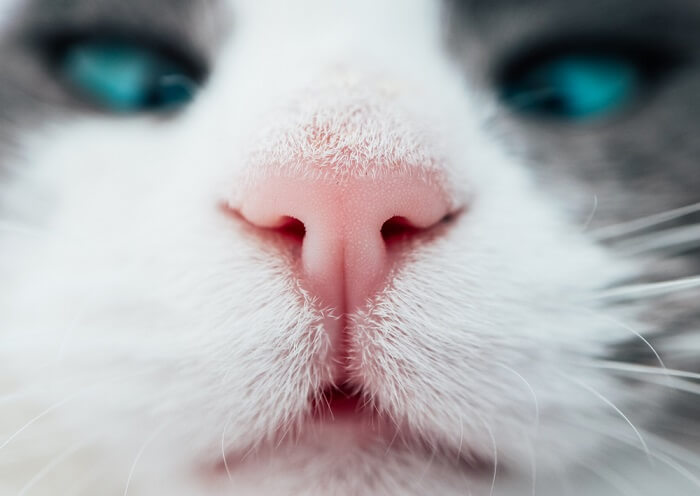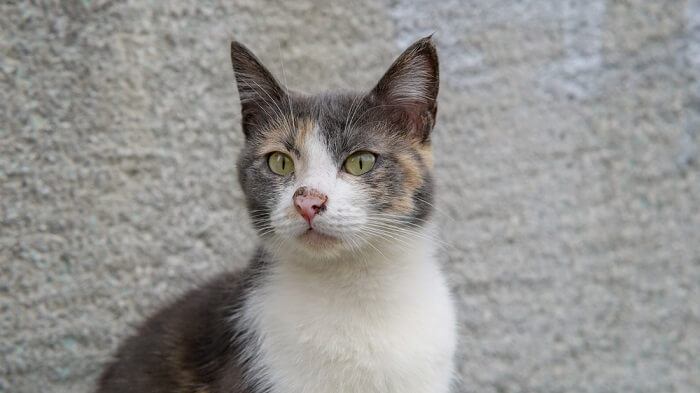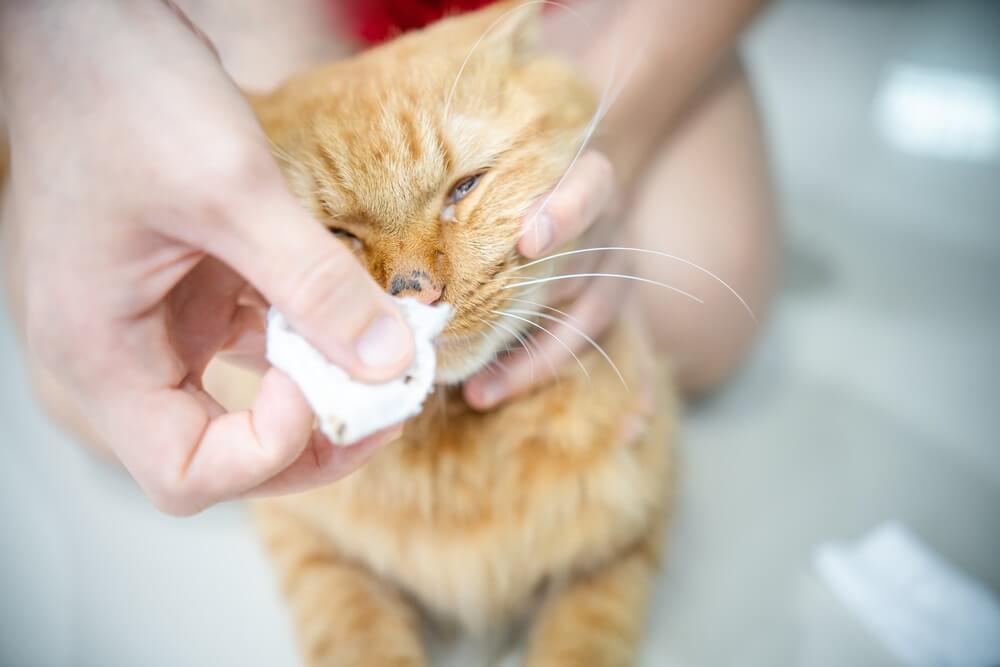
While cancer of the nose (nasal cancer) is relatively uncommon, it can significantly decrease an affected cat’s quality of life. In many cases, the early signs of nasal cancer are indistinguishable from other illnesses.
A cat with early nasal cancer may look like he just has a mild upper respiratory infection or a small scab on the nose.
By the time the cat develops severe or prolonged enough signs that a further workup is considered, cancer can do a lot of damage to the nasal passages and even the skull. This makes nasal cancer challenging to treat.
Quick Overview: Nose Cancer in Cats







What Is Nasal (Nose) Cancer in Cats?
Nasal cancer refers to any tumor that occurs on the nasal planum (the exterior surface of the nose) or within the nasal cavity. Some nasal tumors are visible on the outside surfaces of the nose, while others are located deep within the nasal passages or sinus.
Nasal tumors are relatively uncommon in cats, accounting for 1-5% of all feline cancers. However, these tumors can cause significant disease. Approximately 90% of nasal tumors are malignant, meaning that they can spread.
Unlike other cancers, however, nasal tumors do not tend to metastasize to distant sites. Instead, they cause significant local damage to the tissues surrounding the tumor. In some cases, these tumors can invade the skull and may even affect the brain.
Nasal cancer is typically diagnosed in middle-aged cats, at eight to ten years of age. However, it can also occur in younger and older cats.
Causes of Nasal Cancer

Lymphoma, or cancer of the lymphocytes, is the most common cause of nasal cancer in cats.
The most common cause of feline nasal cancer is lymphoma. Lymphoma is a cancer of the lymphocytes, which are white blood cells that function as part of the immune system. It can affect many different regions of the body, one of which is the nasal passages.
There are a number of factors that increase the likelihood of a cat developing lymphoma, including Feline Leukemia Virus (FeLV) infection, Feline Immunodeficiency Virus (FIV) infection, and exposure to smoke. It is also suspected that chronic inflammation may play a role in lymphoma, although this has not been definitively proven.
The second most common type of nasal cancer in cats is carcinoma, which is a tumor that arises directly from the cells that line the nasal passages. Common nasal carcinomas in cats include adenocarcinoma and squamous cell carcinoma (SCC). These tumors can develop on the internal or the exterior surface of the nose.
Cats can also develop sarcomas, such as fibrosarcoma, that affect the nose.
Symptoms of Nasal Cancer
The signs of feline nasal cancer typically can’t be distinguished from the signs of an upper respiratory infection or other nasal disorder. Therefore, it’s often only when signs persist despite treatment that a nasal tumor is suspected.
Clinical signs of nasal cancer may include:
- Excessive or frequent sneezing
- Nasal discharge
- Nosebleeds
- Snoring in a cat that has always been a quiet sleeper
- Visible nasal swelling or facial deformity
- Pawing at face or rubbing the face on objects
- Weight loss
- Decreased appetite or anorexia
If your cat is showing these signs and the signs persist longer than expected for a simple upper respiratory tract infection, your veterinarian may want to start the process of ruling out a nasal tumor.
Diagnosis of Nasal Cancer in Cats

Your veterinarian can diagnose nasal cancer, starting with a physical examination and moving into blood testing and more.
Physical Examination
Your veterinarian will begin by performing a thorough physical examination. In addition to evaluating your cat’s overall health and body condition, he or she will examine your cat’s nose carefully, looking for signs of discharge and asymmetry.
Airflow from the nostrils will be assessed and your veterinarian may look into your cat’s nasal passages using a bright light.
Blood Testing
The next step in the workup of a cat with chronic upper respiratory signs is blood tests. A complete blood cell count and serum biochemistry test will be performed to look for internal diseases that may predispose your cat to respiratory issues. Additionally, your veterinarian may test your cat for Feline Leukemia Virus and Feline Immunodeficiency Virus.
These viruses can play a role in upper respiratory signs in multiple ways; they can make cats more prone to upper respiratory infections by suppressing their immune system, but they can also make cats more prone to developing lymphoma.
After performing these basic tests, your veterinarian will likely recommend further testing.
There are a number of tests that are likely to be recommended in a cat with a suspected nasal tumor, although the exact order of these tests may vary.
Recommended tests may include:
- Skull radiographs (x-rays)
- Computed tomography (CT scan) or magnetic resonance imaging (MRI) of the skull
- Nasal flush, in which a small amount of saline is flushed into the nose and recovered for evaluation under the microscope
- Rhinoscopy, in which a small camera is inserted into the nasal passages
- Fine needle aspirate or biopsy of the mass, used to collect cells from a mass for microscopic evaluation
- Aspirate of the lymph nodes, used to look for signs of metastasis
Multiple tests are often required for the definitive diagnosis of nasal cancer in cats.
Nasal Cancer in Cats Treatment
Treatment options for tumors of the nose vary, depending on the type of tumor, the size of the tumor, and the tumor’s location. In general, nasal tumors cannot be surgically removed. In most cases, there is not enough tissue present in the area to get “clean margins” with surgery.
Nasal lymphoma in cats is treated primarily with chemotherapy, just like other forms of feline lymphoma. In some cases, radiation therapy may be recommended in addition to chemotherapy. This can help shrink the tumor, improving the cat’s quality of life and allowing chemotherapy to be more effective.
Other feline nasal tumors are treated primarily with radiation therapy. In some cases, radiation therapy can lead to a complete cure of nasal cancer. Even if radiation therapy is not curative, radiation can shrink the lesions and improve your cat’s quality of life.
Both chemotherapy and radiotherapy have side effects. Your cat’s oncologist will talk to you about what to expect with your cat’s treatment. If your cat is not a good candidate for oncology treatment, or if you decline this treatment, your veterinarian can talk to you about palliative care (hospice) options.
Conclusion
Chronic nasal signs in cats can be frustrating because there is always a question of whether it’s an innocuous upper respiratory infection or something more sinister.
If your cat has severe or ongoing upper respiratory issues, such as sneezing or nasal discharge, talk to your veterinarian about appropriate diagnostics. While nasal cancer is relatively uncommon in cats, it can occur. Early diagnosis and early treatment will translate to better outcomes for your cat!
Frequently Asked Questions
How long will my cat live with a nose tumor?
Your cat’s prognosis will depend upon the type of cancer that is present in the nose. Survival times for lymphoma, the most common malignant nasal cancer, range from several months to several years.
What does skin cancer look like on a cat’s nose?
The appearance of skin cancer on a cat’s nose can vary. A squamous cell carcinoma on the nose of a cat may start off looking like a small scab or abrasion, but over time the mass will begin to grow and swell.
How fast does nasal cancer grow in cats?
Without treatment, nasal cancer in cats can grow quickly. Depending on the type of cancer that is present, radiation therapy and/or chemotherapy may help put the tumor into remission.








There is no relation to either of the cats as they come from different parts of the country. I have changed all of the bowls for my five cats to ceramic or stainless steel.
She is currently doing very well after having been given long lasting antibiotic and anti-inflammatory injections about three weeks ago and needs to go back to the vet next week for more.
Although the article claims that nose cancer in cats is rare I have had two cats within the last 6 years have this. One has just been diagnosed with this the other I had to have him put to sleep 5 years ago as it went to his brain. He did survive a couple of years after diagnosed with anti inflammatory and antibiotic treatment. We don’t smoke and live in a rural area.
What they had in common was that the first one had a pink plastic feeding bowl. After he passed I gave his bowl to the other cat now she has the same condition. Could it possibly be something carcinogenic in the make up of the bowl? I have thrown it out just in case.
Hi Linda, I’m sorry you’re going through this. Some plastic materials may involve carcinogenic chemicals, and I don’t think we can entirely rule out a connection. Exposure to cigarette smoke and other environmental contaminants could contribute as well. There may also be hereditary factors involved here, so if your two kitties are related, that may be something to consider. I wish you all the best.
I’m very sad
Aww, Valerie…I’m sorry. Hope you feel better soon.
Thank you. I’m pretty sure this is what my cat has just waiting on my vet to call with test results
this is a great article and all the signs you have pointed out my cat is showing. we are currently having CT scans and biospy yesterday. my cat is also 13 and eats well but the nose bleeds, loud breathing noises etc are very much a concern. can you clarify in your article you said smoking(or exposure to smoking) can bring on this cancer. neither myself or husband smoke but our neigbour does and his smoke drifts over to our front veranda where my cat likes to sleep. would this have contributed or do you mean excessive exposure (like if he was an indoor cat and we both smoked?)
I have been researching online for a week about nasal cancer in cats but none of the articles I have read have my cats symptoms. He has a hole under 1 of his nostrils but he is eating great, playing and acting completely normal. He is not snoring or having excessive sneezing. He doesn’t look like any of the pictures of cats with cancer.
I would recommend taking your cat to a vet to get a real answer. Wishing you all the best!
I did. They are suggesting a biopsy but he’s around 13 and I don’t know if it’s a good idea. He’s acting perfect. He ate an entire large can if food this morning since getting an antibiotic shot last week.